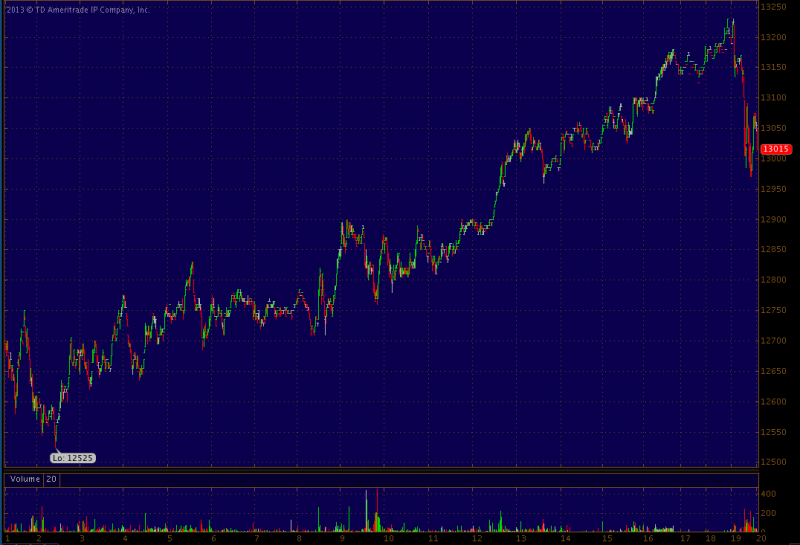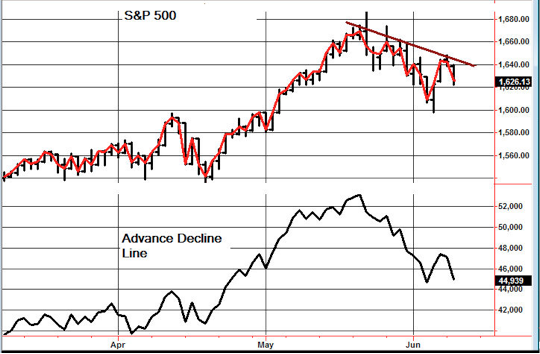Stocks & Equities
Nikkei Drops Fast After Bank Of Japan Minutes
After Nikkei futures rose as high as 13,225 earlier (up 6.3% from Thursday’s close), they have taken a sharp turn lower following the release of the minutes from the Bank of Japan’s May 21-22 policy meeting.
Right now, the Nikkei is trading around 12,995, up *only* 4.4%.

….read more HERE including the key paragraphs from the minutes:

 When it rose past 100%
When it rose past 100%
Last year, Singapore real estate investment trusts (REITs) went up by 40%, and they are up higher this year. But I don’t think that they are the greatest bargain at the moment. Right now, high dividend-yielding stocks are moving up hugely.
My sense is that we are in a market similar to the Nasdaq 100 between November 1999 and March 2000 when it rose past 100%, or the oil price between February 2008 and July 2008 when it shot up 70%. When there is upside acceleration, it’s a bad time to buy. Is it a good time to short? Yes, if you have deep pockets, maybe it’s a good time to short the equity markets. But who knows?
….newer posts from Marc below:
Marc Faber’s Favorite Singapore REITs
Gold has far outperformed Financial Assets since 1999
Most of my GOLD is in a safe-deposit box in Switzerland, but I am shifting it to Asia

Todd Market Forecast for Tuesday June 11, 2013
Available Mon- Friday after 6:00 P.M. Eastern, 3:00 Pacific (for a list of servicers go HERE)
DOW – 117 on 2150 net declines
NASDAQ COMP – 37 on 1150 net declines
SHORT TERM TREND Bullish
INTERMEDIATE TERM TREND Bearish
STOCKS:
A sense that the World’s central banks are going to cut back on money printing keeps affecting the stock markets. Today, there was disappointment that the Bank of Japan left things unchanged and this caused heavy selling in Europe that spread to our shores.
Some are saying that when the Fed takes its foot off the accommodation pedal, it will be bullish because that would suggest a better economy. We disagree. In the past, when the Fed stopped easing, stocks have had a tendency to drop.
GOLD:
Gold was down sharply in the early going, but fought its way back. It was still down $9. Rising rates seem to be the catalyst for pushing gold down. We’ll stay in the bullish camp until and unless support is broken.
CHART:
Yesterday, we showed you a chart indicating that the S&P 500 had bested a previous high. But, there is another methodology that sends out a less bullish message. Note that there is a descending peaks pattern that still needs to be bested. We don’t like this methodology as well as the one described yesterday, but it does have a place. Also, note that the advance decline line is closer to its previous low than the index is. This can be a problem.

TORONTO EXCHANGE: Toronto was down 159.
S&P\TSX Venture Comp: The Venture Comp lost 9.
BONDS: Bonds were early, but managed to reverse.
THE REST: The dollar got whacked pretty good. Silver, crude and copper were all down.
BOTTOM LINE:
Our intermediate term systems are on a sell signal as of June 4, 2013.
System 2 traders We had a signal. Buy the E-mini S&P 500 futures contract and/ or the SSO. The E-mini trades all night. The SSO trades until 8 p.m. EST. We’ll assume the price for both at that time.
System 7 traders We are in cash. Stay there on Wednesday.
Stock investors We are long Intel from 21.61 with a stop at 22.50.
NEWS AND FUNDAMENTALS:
There were no important economic releases on Tuesday and there are none on Wednesday. Obviously a very slow week.
————————————————————————————
We’re on a sell on bonds as of June 10.
We’re on a sell for the dollar and a buy for the euro as of May 20.
We’re on a buy for gold as of May 20.
We’re on a sell for silver as of May 15.
We’re on a sell for crude oil as of May 29.
We’re on a buy for copper as of May 3.
We’re on a sell for the Toronto Stock exchange TSX as of June 5.
We are on a sell for the S&P\TSX Venture Comp. as of Jan. 29.
 INDICATOR PARAMETERS
INDICATOR PARAMETERS
Monetary conditions (+2 means the Fed is actively dropping rates; +1 means a bias toward easing. 0 means neutral, -1 means a bias toward tightening, -2 means actively raising rates). RSI (30 or below is oversold, 80 or above is overbought). McClellan Oscillator ( minus 100 is oversold. Plus 100 is overbought). Composite Gauge (5 or below is negative, 13 or above is positive). Composite Gauge five day m.a. (8.0 or below is overbought. 13.0 or above is oversold). CBOE Put Call Ratio ( Below .80 is a negative. Above 1.00 is a positive). Volatility Index, VIX (low teens bearish, high twenties bullish), VIX % single day change. + 5 or greater bullish. -5 or less, bearish. VIX % change 5 day m.a. +3.0 or above bullish, -3.0 or below, bearish. Advances minus declines three day m.a.( +500 is bearish. – 500 is bullish). Supply Demand 5 day m.a. (.45 or below is a positive. .80 or above is a negative).
No guarantees are made. Traders can and do lose money. The publisher may take positions in recommended securities.
Ed Note: For a complete list of Stephen Todd’s services go HERE
RANKED # 1 BY TIMER DIGEST
Timer Digest of Greenwich, CT monitors and ranks over 100 of the nation’s best known stock market advisory services.
Once per year in January, Timer Digest publishes the rankings of all services monitored for multiple time frames.
For the years 2003, 2004 and 2005, The Todd Market Forecast was rated # 1 for the preceding ten years. For the year 2006, we slipped to # 3 and in 2007, we were ranked # 5.
Our bond timing was rated # 1 for the years 1997, 2007 and 2008.
Gold timing was rated # 1 for 1997 and # 2 for 2006. Late word! We were rated # 1 for 2011.
We were # 1 in long term stock market timing for the years 1998 and 2004 and # 4 in 2010.
To subscribe go to Contact Us.

THE MAY 22nd ‘KEY REVERSAL’ TRIGGERED A NEARLY A 700 POINT CORRECTION IN THE DJ AND a 87 POINT CORRECTION IN THE S&P. THAT MAY HAVE BEEN IT! WATCH TODAY’S TURNAROUND TUESDAY AND THE BANKING STOCKS FOR A SIGN THAT WE COULD BE HEADED TO NEW HIGHS. THE CAVEAT IS THAT IF THURSDAY’S LOWS (E.G., 1598 SPX) DOES NOT HOLD GOING FORWARD, THE ‘SELL MAY AND GO AWAY’ WILL BE RIGHT ON TARGET TO THE EXTENT OF 1525 SPX and 14198 DJ.

———————————————
Unlike Friday, the stock market didn’t provide a lot of trading excitement on Monday. The major indices spent time on either side of the unchanged mark, but were never able to achieve a good deal of separation either way as buyers and sellers alike lacked conviction. There was some initial excitement when it was announced before the open that Standard & Poor’s raised its US outlook to Stable from Negative, citing a lessening of downside risks to its AA+ rating for US sovereign debt. That positive-sounding headline helped stocks get off to a decent start, yet buying efforts soon tapered off as a concurrent rise in long-term interest rates seemed to limit the stock market’s enthusiasm for the outlook change. The yield on the 10-year note moved up to 2.23%, or roughly six basis points higher than where it settled on Friday. The move was striking considering the switch by Standard & Poor’s should have been construed as a good thing for the Treasury market. The ensuing weaknes s, though, seemed to fit with the sense that an improving economic outlook would lessen the safety premium in Treasuries and encourage a rotation into stocks. Nonetheless, not all participants are convinced that the economy will gain steam in coming months; hence, there were some underlying concerns that the jump in rates could retard the recovery as they interfere with the rebound in the housing market.
There wasn’t any economic data out on Monday, but ‘talking mouthpiece’ St. Louis Fed President Bullard did address economic conditions in a speech on the global economy. Mr. Bullard is a voting FOMC member and he walked the party line of providing a little something for everyone in the tapering debate. To wit, he suggested the low rate of inflation could be justification for the Fed to maintain its aggressive asset buying over a longer time frame and then added that an improved labor market could mean the Fed might slow the pace of its asset purchases.
The Wholesale Inventories report for April (Briefing.com consensus +0.2%; prior +0.4%) is the only piece of US data slated for release on Tuesday. It won’t be a market mover, so the direction of currencies and interest rates could be dictating factors along with any new insight from Germany’s Constitutional Court on the legality of the eurozone’s crisis-management measures.
Also, it’s TURNAROUND TUESDAY. With Monday down, can we expect a nice pop? Watch XLF (the banking ETF) and names in the sector. Goldman Sachs (GS) broke out on Monday and that could be telling us we’re looking at new highs.

“Washington’s witch hunt can — and is — hurting the securities markets.
It can mean the difference between making oodles of money in the months and years ahead, or losing oodles of money”
I’VE NEVER BEEN MORE OUTRAGED AT WASHINGTON
The National Security Agency’s order for Verizon to turn overall customer records is an abomination on the rights and liberties of every American. I am outraged. I’m sure you are too.
I have never felt such anger at Washington. Our founding fathers must be turning over in their graves. What have we come to? Is America now a fascist state? Are we heading toward communism?
When will it stop?
I’m afraid it won’t. If you think there’s been a loss of privacy and liberty since George W. Bush took office 13 years ago, brace yourself ? it’s about to get a lot worse.
It’s what happens when governments start to fight for their survival. It happened in Rome. In Byzantium. In the Weimar Republic in Germany. And in countless other countries where governments became desperate for revenue and started losing the confidence of their citizens.
They start invading upon citizens’ privacy and liberties. They start regulating everything in sight. And they start taxing just about anything that moves.
 Why is it about to get a whole lot worse for us Americans? There are several reasons.
Why is it about to get a whole lot worse for us Americans? There are several reasons.
First, as you well know, Washington is dead broke. If it weren’t for the Federal Reserve buying $85 billion in Treasuries each month and the good graces of China and other countries still extending credit to Washington ? the government would have shut down long ago.
Second, Washington sees what’s happening in the streets of Greece, France, Spain, Turkey and other countries: Massive social unrest, protests, civil war.
So Washington is preparing to head off the same here, expecting social unrest to eventually strike our country. The Department of Homeland Security is loading up with tanks and millions of bullets, real and rubber.
Drones can now fly right over your home or business, and monitor your comings and goings.
Have a nice car that the IRS might think is too expensive for your lifestyle based on your tax return? Be careful. A drone could be reporting it to the IRS, triggering an audit.
Laptops and cell phones can be confiscated and searched ? without a warrant ? when you return from your overseas vacation.
The FBI and National Security Agency are monitoring the servers of nine huge American Internet companies, monitoring audio and video chats, how you surf the web, what you surf for and more.
Wiring money overseas for as little as $3,000 is now reportable to the government by your bank.
We live in a virtual fascist police state.
Of course, those in power in Washington will always claim that it’s all in defense of our country, to ferret out terrorism. But that’s a ruse.
It’s exactly the opposite: It’s to terrorize you into complying with every inch of red tape the government issues.
To pay every penny of tax and more they think you owe.
And to ultimately force the U.S., and eventually the global monetary system, into a cashless digital currency so they can track every penny of wealth you have.
That’s where we’re headed: George Orwell’s “1984″ — but worse.
But it’s not only happening in the U.S. It’s also taking place in France, Germany, Italy, Spain, and just about every country where governments are having financial trouble.
And it’s amazingly ironic that a true communist country like China ? for all its faults ? is going in the opposite direction. Becoming more democratic, more free, more supportive of business.
Don’t get me wrong: The U.S. is still the greatest country on the planet. I am American and always will be. Though I live overseas, I have no plans whatsoever to give up my citizenship and become an expatriate.
But I don’t like where our country is headed, not by a long shot. I am outraged.
And whether you are or you aren’t, I think it’s also critically important that you understand how Washington’s witch hunt can — and is — hurting the securities markets.
It can mean the difference between making oodles of money in the months and years ahead, or losing oodles of money.
I see three major consequences of Washington’s ? and other governments’ ? efforts to track and tax your wealth:
First, it’s going to do exactly the opposite of what the government intends. It’s going to send more and more small-business transactions underground.
It’s going to create more and more barter. More attempts at private digital currencies like Bitcoin. It’s going to send money into hiding, to the extent possible these days.
Second, it’s going to send more and more money ? and assets ? offshore. Yes, any money you place offshore, any gold or silver bullion, needs to be reported to the IRS.
But that won’t stop money and precious metals from heading offshore. In the minds of most investors ? and I agree ? the further away from Washington’s reach your money and many of your assets are, the better.
Third, and most importantly, it’s going to have a mind-boggling effect on nearly all financial markets.
Namely, it’s going to drive capital in a way that is constantly seeking out what I call “portability and fungibility.”
Portable wealth is money and assets that can be easily transported, and more easily hidden from view. Examples: Artwork, diamonds, jewelry, gold and silver coins, numismatics and more.
But portability does not stop there. Portability can also be assets that are deemed non-confiscatable, such as stocks. Own a government bond, and Washington knows you own it. Own a share in Apple, and it’s unlikely Washington will subpoena Apple for a record of your shares.
But even if it were to do so, you have an option: You can take possession of your Apple stock certificate, and get out of your brokerage account and be somewhat further removed from the government’s prying eyes.
That’s one of the reasons there’s been a rise in shareholders taking street delivery of their stock certificates over the past year or so: To get it off the grid, so to speak.
It’s also one of the reasons I see the stock market doing well for years to come. It’s a private-sector investment. Not only are there loads of companies in better shape than the U.S. government, stocks are considered an asset class free from government confiscation.
Stocks ? and especially gold and silver ? are also fungible. When you need cash, digital or otherwise, stocks and gold and silver are easily converted back to a more easily used medium of exchange.
Portability and fungibility are going to be major forces behind the next bull leg higher in gold and silver, which is now closer than ever.
Ditto for stocks. Speaking of which, the short-term correction I warned you about in my last column appears to have arrived.
The S&P 500 Index closed below 1,644.50 ? the signal I gave you in my last column ? and then promptly fell even further, shattering the
1,621 level I also gave you in that column.
The market is now positioned for a solid pullback of as much as 10 percent. But don’t let it throw you off-base. For many of the reasons I just mentioned, and others I’ve written about, the U.S. equity markets are headed much higher over the long-term.
Not despite the problems our country has, but because of them!
If you acted on my suggestion last week to purchase shares in the triple-leveraged inverse ETF, the ProShares UltraPro Short S&P 500 ETF (SPXU), then you’re sitting pretty. Hold that ETF.
Best wishes and stay tuned …
Larry












